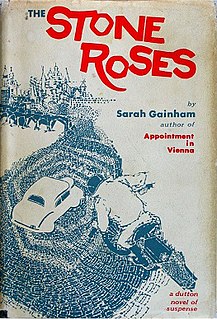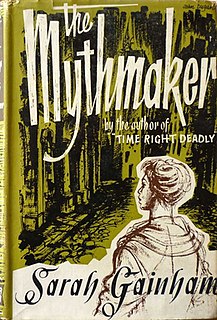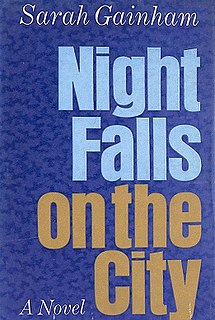Spy fiction is a genre of literature involving espionage as an important context or plot device. It emerged in the early twentieth century, inspired by rivalries and intrigues between the major powers, and the establishment of modern intelligence agencies. It was given new impetus by the development of fascism and communism in the lead-up to World War II, continued to develop during the Cold War, and received a fresh impetus from the emergence of rogue states, international criminal organizations, global terrorist networks, maritime piracy and technological sabotage and espionage as potent threats to Western societies. As a genre, spy fiction is thematically related to the novel of adventure, the thriller and the politico-military thriller.
Leonard Cyril Deighton is a British author. His publications have included cookery books, history and military history, but he is best known for his spy novels.

Billion-Dollar Brain is a 1966 Cold War spy novel by Len Deighton. It was the fourth to feature an unnamed secret agent working for the British WOOC(P) intelligence agency. It follows The IPCRESS File (1962), Horse Under Water (1963), and Funeral in Berlin (1964). As in most of Deighton's novels, the plot of Billion Dollar Brain (1967) is intricate, with many dead ends.

The Spy Who Came in from the Cold is a 1963 Cold War spy novel by the British author John le Carré. It depicts Alec Leamas, a British agent, being sent to East Germany as a faux defector to sow disinformation about a powerful East German intelligence officer. It serves as a sequel to le Carré's previous novels Call for the Dead and A Murder of Quality, which also featured the fictitious British intelligence organization, "The Circus", and its agents George Smiley and Peter Guillam.

Ethel Lilian Voynich, néeBoole was an Irish-born British novelist and musician, and a supporter of several revolutionary causes. She was born in Cork, but grew up in Lancashire, England. Voynich was a significant figure, not only on the late Victorian literary scene, but also in Russian émigré circles. She is best known for her novel The Gadfly, which became hugely popular in her lifetime, especially in Russia.

The Gadfly is a novel by Irish-born British writer Ethel Voynich, published in 1897, set in 1840s Italy under the dominance of Austria, a time of tumultuous revolt and uprisings. The story centres on the life of the protagonist, Arthur Burton. A thread of a tragic relationship between Arthur and his love, Gemma, simultaneously runs through the story. It is a tale of faith, disillusionment, revolution, romance, and heroism.
Rachel Ames, née Stainer was a British novelist and journalist who wrote under the pseudonym Sarah Gainham. She is perhaps best known for her 1967 novel Night Falls on the City, the first of a trilogy about life in Vienna under Nazi rule.
Len Deighton is an English author known for his novels, works of military history, screenplays and cookery writing. He had a varied career, including as a pastry cook, waiter, co-editor of a magazine, teacher and air steward before writing his first novel in 1962: The IPCRESS File. He continued to produce what his biographer John Reilly considers "stylish, witty, well-crafted novels" in spy fiction, including three trilogies and a prequel featuring Bernard Samson.

Time Right Deadly is a 1956 thriller novel by the British writer Sarah Gainham. Her debut novel, it was shortlisted for the Gold Dagger Award, losing out to Edward Grierson's The Second Man. Like many of her novels it takes place in post-war Austria, where she lived.

The Stone Roses is a 1959 spy thriller novel by the British writer Sarah Gainham. It is set in Prague shortly after the Communist coup in Czechoslovakia.

The Mythmaker is a 1957 spy thriller novel by the British writer Sarah Gainham, her third published novel. At with many of her works it takes place in Vienna, where she settled in the post-war era. It was released in the United States in 1958 under the alternative title Appointment in Vienna.

Night Falls on the City is a 1967 novel by the British writer Sarah Gainham. A commercial and critical success, it was the first of her Vienna trilogy followed by A Place in the Country (1969) and Private Worlds (1971). Marking a change from the series of spy thrillers she produced in the 1950s, it remains her best-known work

A Place in the Country is a 1969 novel by the British writer Sarah Gainham. It was the second in her Vienna trilogy following on from the popular first novel Night Falls on the City.

Private Worlds is a 1971 novel by the British writer Sarah Gainham. It was the third in her Vienna trilogy following on from the popular first novel Night Falls on the City.

The Silent Hostage is a 1960 spy thriller novel by the British writer Sarah Gainham. Before writing her most celebrated work Night Falls on the City, Gainham produced several thrillers set in Continental Europe where she had lived since 1947. The novel takes place on the Adriatic Coast of Yugoslavia not long after the Second World War.

A Forest of Eyes is a 1950 spy thriller novel by the British writer Victor Canning. Stylistically it owed a debt to Canning's friend, the writer Eric Ambler.

The Whip Hand is a 1965 spy novel by the British writer Victor Canning. It is the first in a series of four novels about Rex Carver, a private detective drawn back into his old profession of espionage. The novel also features the secret service agent Manston who had previously appeared in The Limbo Line, Canning's previous novel.

The Python Project is a 1967 spy thriller novel by the British Victor Canning. It is the third in a series of four novels about Rex Carver, a private detective drawn back into his old profession of espionage. A complex plot which involves a jewel robbery and the exchange of prisoners between the British and Soviet intelligence services takes place in a variety of locations including London, Paris, Libya and the Balearic Islands.

The Melting Man is a 1968 thriller novel by the British Victor Canning. It is the fourth and final entry in a series novels about Rex Carver, a private detective drawn back into his old profession of espionage. It features the French secret agent Aristide de la Dole, who had previously appeared in Doubled in Diamonds.

Firecrest is a 1971 spy thriller novel by the British writer Victor Canning. A stand-alone novel, it introduced a more modern, darker and naturalistic style compared to Canning's previous novels. It marked the first appearance of "The Department", a shadowy dirty tricks agency working for the British government which featured in subsequent novels.
















